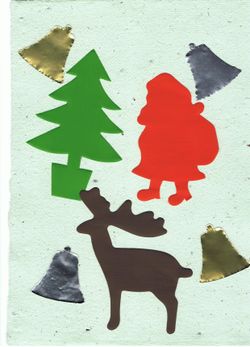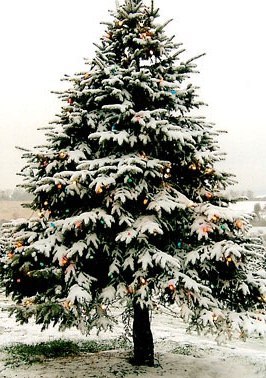 Have you ever considered trying to grow your own Christmas tree? Or wondered what paper made of reindeer poo would be like…? How about combining the two – a little natural fertlizer perhaps? Well somebody has… The Exotic Paper Company, better known for its Ellie Poo and Rhino Poo papers (made from elephant and rhino poo!), is now selling Reindeer Poo paper (pictured on the left) that has growable Christmas tree seeds in it!
Have you ever considered trying to grow your own Christmas tree? Or wondered what paper made of reindeer poo would be like…? How about combining the two – a little natural fertlizer perhaps? Well somebody has… The Exotic Paper Company, better known for its Ellie Poo and Rhino Poo papers (made from elephant and rhino poo!), is now selling Reindeer Poo paper (pictured on the left) that has growable Christmas tree seeds in it!
The handmade paper can be used, then planted in your back garden to grow real Christmas tree plants. The paper is 100% recycled and some of the profits made by the company go to conservation projects around the world, including The Millennium Elephant Foundation, The Elephant Family and Save the Rhino International.
So, aside from reindeer poo paper, how do you grow your own Christmas tree? Read on…
The BBC offers some advice on growing Christmas trees:
- Choose your tree and buy seed – the internet is a good source.
- Fill a pot with peat-free compost for seedlings.
- Sow seeds on the surface.
- Cover with horticultural grit that is twice the size of the seedlings. This allows more air to circulate and protects the seedlings when watering from the top and also recreates natural conditions.
- Sow in February and provide bottom heat in May. Keep well watered in a greenhouse.
- Once the seedlings emerge, prick out and transplant into 10cm (4in) pots.
- Keep potting on as seedlings grow over the first 12 months.
- Plant out when it is one year old.
Species choice:
Don't plant Norway spruce (Picea abies) unless you have a very large garden! It grows to about 30m (100ft) and drops needles all year. Instead, try:
- Korean fir (Abies koreana) – grows to 12m (40ft) and therefore more suitable for the smaller garden.
- Noble fir (Abies procera) – silvery-blue, fragrant tips, smooth, grey bark, and good needle retention.
- Fraser fir (Abies fraseri) – soft needles, which also hold well, good shape and strong boughs that are ideal for supporting heavy ornaments.
Here are a few Christmas tree facts, courtesy of the National Christmas Tree Association, USA:
- It can take as many as 15 years to grow a tree of typical height (6-7 feet) or as little as 4 years, but the average growing time is 7 years.
- The most common Christmas tree species are: balsam fir, Douglas-fir, Fraser fir, noble fir, Scotch pine, Virginia pine and white pine.
- For every real Christmas tree harvested, 1 to 3 seedlings are planted the following spring.
- Real trees are a renewable, recyclable resource. Artificial trees contain non-biodegradable plastics and possible metal toxins such as lead.
- There are close to 350 million real Christmas trees currently growing on Christmas tree farms in the USA alone, all planted by farmers.
 To find out about the latest scientific research on Christmas trees take a look at CAB Abstracts – it contains more than 600 abstracts on Christmas trees, including:
To find out about the latest scientific research on Christmas trees take a look at CAB Abstracts – it contains more than 600 abstracts on Christmas trees, including:
– Growth and physiology of newly planted fraser fir (Abies fraseri) and Colorado blue spruce (Picea pungens) christmas trees in response to mulch and irrigation. Cregg, B. M.; Nzokou, P.; Goldy, R. (2009) HortScience 44 (3), 660-665.
– Weed control measures in Christmas tree plantations of Abies nordmanniana and Abies lasiocarpa on agricultural land. Sæb, A.; Flistad, I. S.; Netland, J.; Skúlason, B.; Edvardsen, M. (2009) New Forests 38 (2), 143-156.
– Susceptibility of Fraser fir to Phytophthora capsici. Quesada-Ocampo, L. M.; Fulbright, D. W.; Hausbeck, M. K. (2009) Plant Disease 93 (2), 135-141.
– Proceedings of the 8th International Christmas Tree Research & Extension Conference, Bogense, Denmark, 12-18 August 2007. Thomsen, I. M.; Rasmussen, H. N.; Srensen, J. M. (2008) Forest & Landscape Working Papers 26, x + 145 pp.
– Provenance variation in germination and seedling growth of Abies guatemalensis Rehder. Andersen, U. S.; Córdova, J. P. P.; Nielsen, U. B.; Kollmann, J. (2008) Forest Ecology and Management 255 (5/6), 1831-1840.
– Containerized table-top christmas trees: interest among Pennsylvania consumers and attitudes concerning care and handling. Kelley, K. M.; Bates, R. M. (2007) Journal of Extension 45 (1), pp 1RIB7.
– Is spruce from northerly regions and from high altitude forests suitable for Christmas tree cultivation in lowland areas of southern Norway? Nyeggen, H.; Skage, J. O.; stgård, Å. (2006) Forskning fra Skog + Landskap 2, 16.
Happy Christmas!
3 Comments
Leave a Reply

Thanks for the information given here today. Anthony
mary christmas. for this chritmas a want a Artificial Christmas Trees because i can have it for many years. i just can not wait to make cookies, to have guests, to go visiting my relatives.
Hugh Press
I loved your article.Really thank you! Awesome.